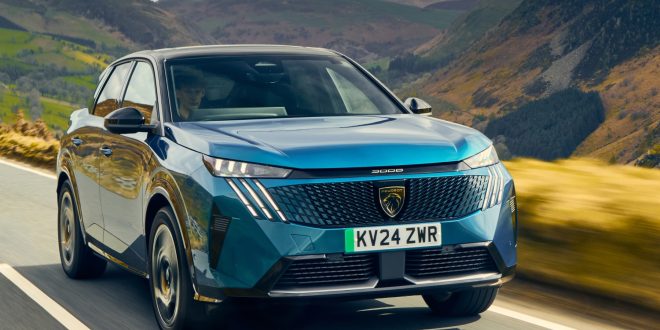We road test the pure electric version of the next-generation Peugeot 3008…
The Peugeot 3008 is a great example of how the automotive industry has evolved since 2007.
Back then it was a dumpy looking MPV, but all that changed in 2016. In one fell swoop, Peugeot’s designers re-invented the 3008 so that it became one of the most stylish and distinctive mid-sized SUVs on the market.
Crowned 2017 European Car of the Year, at launch it was available with a choice of petrol and diesel engines, though mild hybrids and a plug-in hybrid followed.
So, that’s SUVs in, diesels out.
The 2024 third generation Peugeot 3008 is greener still, and is first model to use parent group Stellantis’ new STLA Medium electric powertrain. Ultimately, there will be mild hybrid, plug-in hybrid and fully electric versions.
It’s on-trend too because it’s marketed as an “electric fastback SUV”, which means it has a sporty, sloping roof.
The first model in the 3008 line-up is the 100% electric E-3008. It will come with two sizes of battery (73kWh or 98kWh batteries), but initially only the former with a claimed 326-mile range will be available.
We’ll have to wait until 2025 for the 98kWh Long Range with an impressive 422 miles on a single charge, and the Dual Motor all-wheel drive (73kWh, 326 miles).
We road tested the entry-level Peugeot E-3008 73kWh Single Motor, which starts at £45,850.
And the good news is that the new 3008 is even more striking than the outgoing car. There’s a bold front end featuring slim LED headlamps integrated into the frameless grille, but the most obvious change is that it now sports an aerodynamic SUV-coupe profile (think Audi Q4 Sportback e-tron).
Naturally, Peugeot’s trademark light signatures feature too – ‘lion’s claw’ LED daytime running lights up front and ‘three-claw’ at the rear.
Inside, there’s the wow factor of Peugeot’s new “Panoramic i-Cockpit”, complete with a floating, curved 21-inch HD screen that combines the head-up display with the central touchscreen.
I’ve had my issues with Peugeot’s i-Cockpit design before, because the dinky, low-set steering wheel and higher dashboard results in a slightly awkward driving position for taller drivers (ie the steering wheel is almost in your lap, otherwise it blocks the dashboard).
Thankfully, this situation is much-improved in the E-3008, though it’s still a quirk.
The main takeaway is that the infotainment screen and instrument cluster are a huge-step up from the previous model. The graphics are still not-class-leading, but it’s a big improvement and works well.
There are no physical buttons, but the touch keys are great and the ability to create shortcuts really boosts usability. There’s also a handy “OK Peugeot” voice assistant.
The cabin is well designed and the quality is impressive as long as you don’t look too far down where more basic scratchy black plastics lurk.
It’s spacious too – not just up front, but at the back (the rakish profile doesn’t appear to have impacted headroom too much) and in the boot, where there’s a 588-litre luggage capacity, expanding to 1,663 litres with the seat folded down.
On the road the front mounted electric motor develops 213bhp and drive is via the front wheels. It’s swift, but not blisteringly fast off the line.
With 253lb ft of torque, it can complete the 0-62mph sprint in a respectable 8.8 seconds and tops out at 105mph.
For the record, the E-3008 is capable of charging speeds up to 160kW, enabling it to be boosted from 20-80% in just 20 minutes (or 30 minutes via a 100kW connection).
It’s easy to drive in urban areas thanks to light steering, a tight turning circle and good visibility for the most part, except for the rear pillars and slim tailgate window.
And despite firm suspension settings and the big 20-inch wheels on our car, it dealt with the lumps and bumps of everyday driving well, only becoming a little unsettled over larger potholes and really poor surfaces.
Grip is good, but the brakes are disappointing (a common issue with EVs) because they lack a progressive feel and have a tendency to snatch.
You’re also aware of its bulk (2,108kg) on more twisty roads, so there is some body lean. In short, it’s at its best and most refined cruising at higher speeds.
The drive modes (Eco, Normal and Sport) tweak the dynamics slightly, but you can’t alter the fact that this is a family five-seater and not one of the more engaging electric SUVs on the market to drive.
On the plus side, there are three levels of regenerative braking that are adjusted via the steering wheel paddles.
We achieved an efficiency of around 3.5 miles per kWh, which would translate to a real-world range of about 270 miles, so the upcoming 98kWh Long Range should be quite the thing when it arrives on the scene.
The Peugeot E-3008 is available with a choice of just two trim levels (Allure and GT) and its many rivals include the Renault Scenic E-Tech, Volkswagen ID.5, Nissan Ariya, Hyundai Ioniq 5, Tesla Model Y, Kia Niro EV, Volvo EC40 and Skoda Enyaq.
Verdict: If you’re looking for a classy and refined family-sized SUV loaded with kit and ample kerb appeal, then the all-new, all-electric Peugeot E-3008 could be the car for you.







